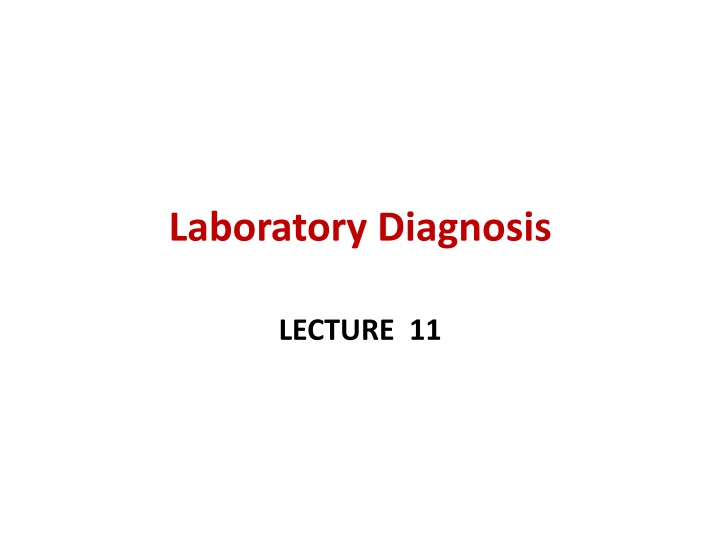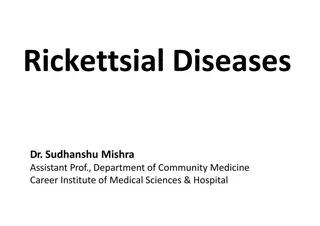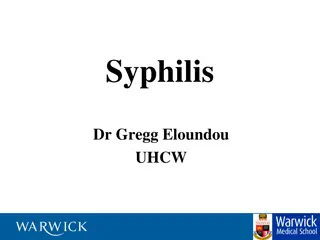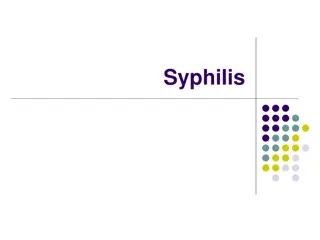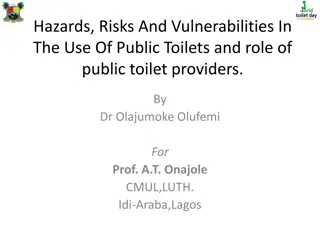Laboratory Diagnosis of Sexually Transmitted Diseases in Men and Women
The laboratory diagnosis of STDs differs between men and women, with specific infections affecting each gender. Various infections are discussed, including vaginitis, trichomoniasis, bacterial vaginosis, cervicitis, genital ulceration, and more. Details on specimen collection methods for both men and women are provided.
Download Presentation

Please find below an Image/Link to download the presentation.
The content on the website is provided AS IS for your information and personal use only. It may not be sold, licensed, or shared on other websites without obtaining consent from the author.If you encounter any issues during the download, it is possible that the publisher has removed the file from their server.
You are allowed to download the files provided on this website for personal or commercial use, subject to the condition that they are used lawfully. All files are the property of their respective owners.
The content on the website is provided AS IS for your information and personal use only. It may not be sold, licensed, or shared on other websites without obtaining consent from the author.
E N D
Presentation Transcript
Laboratory Diagnosis LECTURE 11
Diagnosis of Sexually Transmitted Diseases The laboratory diagnosis of STDs is related to the sex of the patient, although some infections are common to both sexes like gonorrhea, syphilis and chlamydial infection but there are differences in the symptoms, the sites and methods of specimens collection in these infections. Genital infections and STDs in women These include: 1-Vaginitis : Is caused by a limited number of infectious agents include: Trichomons vaginalis
Trichomoniasis: is an infection of urogenital tract and the most common site of infection is the urethra and vagina in women, it is caused by the single-celled protozoan parasite Trichomons vaginalis which classically produce a copious, frothy yellow or yellow-green discharge. Candida albicans Vulvovaginal Candidiasis: is caused by Candida albicans, squamous epithelial cells of vaginal is invaded and inflamed causing vaginal discharges and pain. Discharge is typically more thick than trichomoniasis and curd like.
2-Bacterial Vaginosis: is caused by a number of infectious agents include: Gardnerella vaginalis Peptocococcus Mycoplasma 3-Cervisitis with or without Urethritis: is caused by gonococci or Chlamidia trachomatis 4-Uterine sepsis: is caused by Str. pyogenes, Staph. aureus, Clostridium and Mycoplasma 5-Genital ulceration: is caused by T. pallidum, Haemophilus ducreyi and ChlamYdia 6-Tuberculosis of uterus:is caused by Mycobacterium tuberculosis 7-Viruses: is caused by viruses like Cytomegalo virus, Herpes
Genital infections and STDs in men The infections in men are mostly caused by the same organisms as in women, include: 1-Urethritis: In men C. trachomatis causes urethritis lead to epididymitis and prostatitis. 2-Prostatitis: caused by gonococci or Chlamydia 3-Ulceration: caused by Herpes simplex virus, T. pallidum, Haemophilus ducreyi and Chlamydia. Collection of specimen in men: Clean around the urethral opening using a swab moistened with sterile physiological saline. When culture is indicated collect a sample of pus on a sterile cotton-wool swab.
Collection of Sample in women: Endocervical canal for isolation N. gonorrhoeae: Use a sterile vaginal speculum to examine the cervix and collected the specimen: Pass a sterile cotton wool swab 20-30 mm into the endocervical canal and gently rotate the swab against the endocervical wall to obtain a specimen Collection of vaginal discharge to detect T. vginalis, C. albicans,G. vaginalis: Two preparations are required: 1-Wet preparation to detect motile T.vaginalis. Use a sterile swab to collect a specimen from the vagina. 2-Dry smear for Gram staining to detect Candida and examine for clue cells Gram positive cells and pseudohyphae of C.albicans
Collection of specimen to detect T. pallidum: 1-Wearing protective rubber gloves, cleanse around ulcer(chancre) using a swab moistened with physiological saline 2-Gently squeeze the lesion to obtain serous fluid collect a drop on a cover glass 3-Immediately deliver the preparation to laboratory for examination by dark-field microscopy
Culture the specimen Different culture media used including: A-Thayer Martin medium. For isolation of N. gonorrhoeae and incubate in moist carbon dioxide enriched atmosphere at 35 37 C for up to 48 hr. Thayer Martin medium contains the antibiotics (Vancomycin, Colistin, Nastatin). B-Blood agar (aerobic and anaerobic) C-MacConkey agar D-Cooked meat medium. When puerperal sepsis or septic abortion is suspected. Incubated specimen in cooked meat medium and incubate at 35 -37 C and then sub culturing as indicated 24 hr,48 hr, 72 hr E-Chocolate agar F-Sabaroued agar. For Candida isolation
PH of discharge: The normal reaction of vaginal discharge (puberty to menopause) is PH 3-3.5 This to indicate the following: T.vaginalis: yellow-green purulent discharge with PH over 5 C.albicans: White odorless discharge with PH below 5 G.vaginalis: Grey offensive smelling (fishy ammoniacal smell) thin discharge with PH over 5 Gram stain to examine: Pus cells containing Gram negative diplococci or pus cells have been damaged and the organism seen lying outside the pus cells that could be N. gonorrhoeae Large G+ve yeast cells and Pseudohyphae that could be C. albicans
septic abortion Smear from a patient with suspected puerperal sepsis or septic abortion, looked especially among pus cells for: Large G+ve rods with straight ends C. perfringens G+ve Streptococci S. pyogenes G+ve cocci- Staph. aureus Wet (saline) preparation to detect T. vaginalis: To detect motile T. vaginalis trophozoites.
Dark field preparation to detect motile T. palladium
Urinary Tract Infection (UTI) Urinary Tract Infection (UTI) is a bacterial infection that affects any part of the urinary tract. The main causal agent is Escherichia coli. The most common type of UTI is acute cystitis often referred to as a bladder infection. An infection of the upper urinary tract or kidney is known as pyelonephritis, and is potentially more serious. Women are more prone to UTIs than men. Factors that increase female susceptibility to UTI: Short length of the urethra Urethral contamination by rectal pathogens Introital & vestibular colonization by pathogenic bacteria Decreased urethral resistance after menopause
Urine culture The urine samples routinely culture on Blood agar and MacConkey agar and now culture on Cystine Lactose electrolyte-deficient (CLED) agar. Incubate the plate aerobically at 35 37C overnight. CLED agar is now used by most laboratories to isolate urinary pathogens because it gives consistent results and allows the growth of both Gram negative and Gram positive pathogens. (the indicator in CLED agar is bromothymol blue and therefore lactose fermenting colonies appear yellow). Possible pathogens: Bacteria: Gram positive: Staphylococcus saprophyticus Staphylococcus aureus Haemolytic streptococci
Gram Negative: E. coli (commonest about 60 90 % of UTI) Proteus species(usually in hospitalized patient & with renal stones) Pseudomonas aeruginosa Klebsiella strains Fungi: Candida species(usually in hospitalized patient, in diabetic patient& immunosuppression) Parasite: Schistosoma haematobium
Purulent exudates, burns, wounds and abscesses One of the most commonly observed infectious disease processes is the production of a purulent (sometimes seropurulent) exudate as the result of bacterial invasion of a cavity, tissue, or organ of the body. A smear for Gram-staining and examination should be made for every specimen Culture All specimens of wounds, burns, pus or exudate should preferably be inoculated onto aminimum of two culture media: A blood agar plate for the isolation of staphylococci, streptococci and Clostridium A MacConkey agar plate for the isolation of Gram-negative rods; All organisms isolated from wounds, pus, or exudates should be considered significant and efforts made to identify them.
Wound swabs Most common pathogens found in wound swabs Enterobacter Enterococci Peptostreptococcus Proteus Pseudomonas Bacteroides Clostridium Candida Staphylococcus aureus Streptococcus Escherichia coli Fusobacterium Klebsiella
The clinically most significant species is Clostridium perfringens. It is commonly associated with gas gangrene. C. perfringens grows rapidly in anaerobic broth with the production of abundant gas. On anaerobic blood agar, colonies of moderate size (2 3 mm) are seen after 48 hours. Most strains produce a double zone of haemolysis: an inner zone of complete clear haemolysis, and an outer zone of partial haemolysis
Eye and Ear infections Ocular infection can be caused by bacteria, viruses, or chlamydia and can be detected by culture. Cotton swab will be used to collect the specimen from infected eye.
culture of ear The culture of ear swab is a lab test. This test checks for germs that can cause infection. The sample taken for this test can contain fluid, pus, wax, or blood from the ear. Cotton swab will be used to collect the specimen from inside the outer ear canal. In some cases, a sample is collected from the middle ear during ear surgery
Specimens of eye and ear Specimens of eye and ear should be inoculated on to a minimum culture media: Blood agar plate for the isolation of staphylococci and streptococci. MacConkey agar plate for the isolation of Gram- negative bacteria. Chocolate agar plate for the isolation of Neisseria. Sabouraud dextrose agar plate for the isolation of fungi.
Antibiotic susceptibility tests Sensitivity (susceptibility) testing is used to select effective antimicrobial drugs. The standardized disc-diffusion method (Kirby Bauer) is used. Disc diffusion techniques are used by most laboratories to test routinely for antimicrobial sensitivity. A disc of blotting paper is impregnated with a known volume and appropriate concentration of an antimicrobial, and this is placed on a plate of sensitivity testing agar (Mueller Hinton agar for most bacteria and blood agar for some bacteria) which uniformly inoculated with the test organism. The antimicrobial diffuses from the disc into the medium and the growth of the test organism is inhibited. Strains sensitive to the antimicrobial are inhibited at a distance from the disc whereas resistant strains have smaller zones of inhibition or grow up to edge of the disc.
All strains of streptococci (such as S. pneumoniae) should be tested on blood agar for susceptibility. All Gram-negative rods and staphylococci were tested on Mueller -Hinton for susceptibility. Strains of H. influenzae and Neisseria should be tested for susceptibility using chocolate agar. Also now automated susceptibility testing by VITEK 2 system have been used, which uses a new fluorescence-based technology to detect the susceptibility of bacterial isolates toward antibiotics. VITEK 2 system was evaluated for the identification and susceptibility testing of gram- negative and positive clinical isolates.
MuellerHinton agar plate
